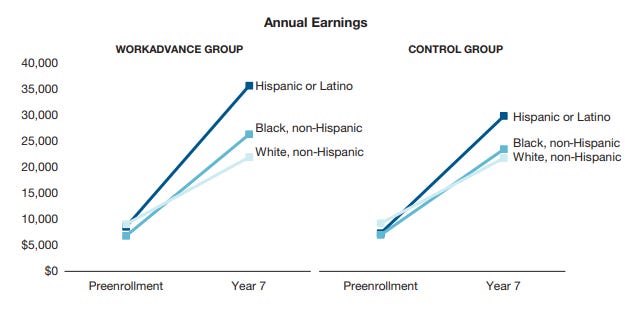Here’s a Kind of Job-Training Program That Works
August 28, 2023
Making ‘sector-based training’ widely available will have to be done carefully.
Job training and workforce development programs have long been plagued by weak wage and job-persistence outcomes. Since the United States spends markedly less on these types of programs than do other developed nations, it’s reasonable to ask whether the weak outcomes are a function of the programs or the funding. Likely, it is a combination of both.
The good news is there are promising alternative approaches to job training that may make a significant difference in employment outcomes. One of the most important is sector-based training, which focuses on the skills needed for specific industries. Studies have shown that participants in sector-based training programs, such as Year Up and Per Scholas, see sustained employment and earnings benefits. The programs have had an especially marked effect on outcomes for disadvantaged and minority workers, who see large sustained increases in wages compared to similar workers who do not participate.

The catch is that in virtually all cases, sector-based training programs are fairly small, with each serving only a few thousand workers per year. If we want to move the needle on economic opportunity, we need to implement policies that can scale proven sector-based training programs to serve tens of thousands.
Scaling successful programs and practices is a real challenge because identifying, analyzing, and replicating the program elements that lead to success requires in-depth research and evaluation as well as patient, well-designed program support. And, when we do know what works, it is often the case that the “secret sauce” is difficult to replicate. For instance, it appears that successful programs are as much due to “best persons”—skilled, dedicated, charismatic leaders and administrators who are able to motivate and lead participants and staff—as to best practices. Program size also seems to be important. Small programs help nurture an environment of close-knit support and personalized attention. Simply expanding programs into larger versions of themselves may lead to failure; careful planning and strong local leadership are needed to replicate the approaches and spirit of the successful models.
A new AEI report on this topic—written by Garrett Yursza Warfield of Year Up, Richard Hendra and Kelsey Schaberg of the nonprofit MDRC, and one of the coauthors of this article (Orrell)—discusses what is needed to make replication and scaling successful. For starters, there’s a need to “educate the educators”: Since not all community colleges and workforce-development systems are already familiar with what sector-based training programs are and how they work, there is a need to aggressively market their effectiveness and to provide clear models. Sharing the successful practices of programs like Year Up, Per Scholas, and others can help inform and inspire local leaders who are looking for workable solutions to labor-shortage problems. The federal government, through the Departments of Labor and Education, has a significant role to play in getting information and program guidance into the hands of those who need them.
A second, related strategy is to leverage our existing training infrastructure, and especially community colleges, to adopt and incorporate proven practices into the way they deliver training. As an example, Project QUEST in San Antonio, Texas has successfully bridged these two worlds—sector-based training and community colleges—providing comprehensive support services to help students at local community colleges complete occupational training programs in skills useful in regional high-growth industries.
To expand existing sector-based training programs, there are several strategies we can pursue—such as expanding admissions, widening the range of occupations the programs cover, incorporating online learning, and offering training services to prepare more job seekers for these programs. These approaches can help to boost demand for these programs and ultimately increase the number of people they serve. Because sector-based training programs are fairly stringent in whom they will accept, in some cases pre-program “on-ramps” may be useful in reaching the “hidden” workers who have the hardest time finding and advancing in work.
Finally, there’s a role for the federal government in expanding programs and seeding new ones. An interesting model can be found in a federal program that has had decades of success in helping states create and support projects that conduct home visits for pregnant women and new mothers, the Maternal, Infant, and Early Childhood Home Visiting (MIECHV) program. Under MIECHV, only organizations that can demonstrate the intent and capacity to replicate evidence-based practices are eligible to receive funding. These requirements are built into the authorizing statute and cascade down into agency grant applications and post-award monitoring and implementation assistance to grantees. This “fidelity by design” grant-making helps to guard against programmatic drift and promote program quality.
Scaling sector-based training programs won’t be easy. Major expansion will require close collaboration between government, local providers, employers, and philanthropy to help expand economic opportunity. But if we succeed, the payoff will be big for American workers and their families.
Sign up for AEI on Vocation, Career, and Work
Biweekly updates from AEI on the latest findings in human capital development, skills training, and strategies for improving pathways to upward mobility